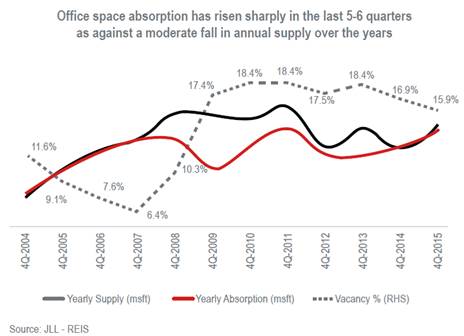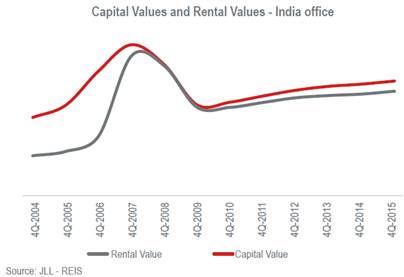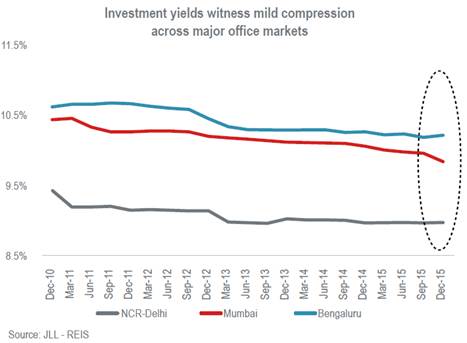 Resurging office demand and lower vacancies across cities driving up rents
Resurging office demand and lower vacancies across cities driving up rents
Anuj Puri – Chairman & Country Head, JLL India
The latest JLL research report ‘Indian real estate: Comprehending the varying speeds of growth’ tracks the journey of different asset classes from 2004 to 2015. Let’s discuss the key trends emerging in the office market:
Office sector showing resurgence
After witnessing sub-30 million sq ft of net absorption for three years in a row (2012-14), 2015 saw absorption rise significantly to above 35 million sq ft. An aggressive expansion strategy adopted by many companies, particularly after going through a slow phase in the immediate preceding years, along with rising prominence of newer players in the ecommerce, healthcare and technology space led to the recent jump in occupancy.
Given that the uncertainty surrounding the general election of May 2014 was behind, and that India’s macroeconomic outlook remained resilient, the entry of foreign firms and expansion of existing firms was imminent and justifiable. Unlike in the previous demand-recovery phase of 2010-11 (post its crash following the GFC) where many occupiers had indulged in opportunistic buying, during 2015 the absorption was growing on the back of both lower rents and a positive economic outlook. Therefore, this recovery looked more sustainable and long-term in comparison with the one we saw in 2011.

There was another aspect which was worth noticing. Since 2014, there has been a positive turnaround in the proportion of Indian companies (or domestic companies) leasing space. Both in 2014 and 2015, share of leasing by domestic firms has pipped that of US companies and stands above 40%. Prior to that, the largest share of leasing was done by companies headquartered in the US. This gives credence to the fact that a positive government which pushes growth results in a positive impact on Indian real estate. The European Union continues to maintain its share in office leasing in the range of 12-15%, thereby giving us some comfort that if Brexit were to directly affect real estate, the adversities are likely to be limited at best.
Falling vacancies give room for rise in rents
A gradual fall in vacancy, which is currently at its seven year-low level of 15.9%, in tandem with the rise in absorption, was a perfect opportunity for rents to rise faster. The growth of office rents had mostly remained marginal across all markets until recent times. Following that, the rise was particularly fast in lower vacancy markets such as Pune, Bengaluru and Hyderabad, and apparently these markets are more preferred by the leasing giants within IT-ITES sector. Few other sub-markets such as Mumbai suburbs, Gurgaon (in NCR) and Chennai SBDs also witnessed moderately higher increase in rents.
There was another aspect which was worth noticing. Since 2014, there has been a positive turnaround in the proportion of Indian companies (or domestic companies) leasing space. Both in 2014 and 2015, share of leasing by domestic firms has pipped that of US companies and 2015, has crossed 40%. Prior to that, the largest share of leasing was done by companies headquartered in the US. This gives credence to the fact that a positive government which pushes growth results in a positive impact on Indian real estate. The European Union continues to maintain its share in office leasing in the range of 12-15%, thereby giving us some comfort that if Brexit were to directly affect real estate, the adversities are likely to be limited at best.

Sectoral share of office occupancy: IT-ITES still dominates, ecommerce makes inroads while manufacturing holds potential
IT-ITES sector has continued to remain the top in terms of share of office occupancy across major Indian cities. The sector continues to maintain its lead with a 35-40% share in office occupancy. Given the rising role of information technology in the context of global and domestic business transactions, we could assume that this dominance might sustain for a few more years. However, there are a few things worth highlighting in the occupancy share. With the increasing push which has been given to manufacturing sector (through initiatives such as Make in India, relaxed FDI norms into defense manufacturing, gradual progress towards a uniform taxation across all states through GST, Skill India, etc.), we could see the share of manufacturing rise in the medium term, from the meagre 15% share it occupies currently.
Ecommerce has played a vital role in changing the shape of retail real estate in India, and its stellar growth rate of more than 50-51% (as mentioned in market reports such as those published by PWC in 2015 and ASSOCHAM-Forrester in 2016) has helped increase its share in office leasing. From being non-existent as an office tenant until 2011-12, the sector now contributes around 4.0% to overall occupancy, which is a considerable growth.

Yield compression across major office markets
Pan-India office market yields have been on a gradual decline since the last 3-4 quarters, largely owing to a faster rise in capital values compared to rents. The major office markets of Mumbai, Bengaluru and NCR-Delhi, which account for 2/3rd of the total Grade-A office markets in India (top-7 cities combined), reflect the same trend of moderately falling yields over the same period.

Given that the market foresees this trend to continue for some more time; both developers and investors have become active in this space. Developers and investors are always looking for faster growth in capital values. Consequently, year 2015 witnessed a record flow of PE investments into real estate, most of which targeted quality assets in major Indian cities.
